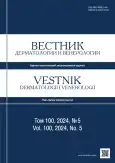Медикаментозные возможности пролонгирования ремиссий атопического дерматита
- Авторы: Кочергин Н.Г.1
-
Учреждения:
- Первый Московский государственный медицинский университет им. И.М. Сеченова (Сеченовский университет)
- Выпуск: Том 100, № 5 (2024)
- Страницы: 61-67
- Раздел: В ПОМОЩЬ ПРАКТИЧЕСКОМУ ВРАЧУ
- URL: https://bakhtiniada.ru/0042-4609/article/view/275716
- DOI: https://doi.org/10.25208/vdv16303
- ID: 275716
Цитировать
Полный текст
Аннотация
Атопический дерматит (АД) является часто встречающимся хроническим рецидивирующим иммунозависимым зудящим дерматозом с типичной клинической картиной и значительным снижением качества жизни больного. Механизм развития заболевания обусловлен генетической предрасположенностью, предопределяющей дефект барьерной функции кожи и гиперактивное функционирование врожденного и адаптивного иммунитета под воздействием триггеров окружающей среды, инфекционных агентов, аллергенов и патогенетических факторов сопутствующих заболеваний. Хронический характер дерматоза, резко сниженное качество жизни больных АД и их плохая приверженность к лечению создают трудности на пути к эффективной терапии пациентов. Преодолеть эти трудности может помочь проактивное применение в наружной терапии больных АД мази такролимус (Протопик®), которая после подавления острой фазы обострения наружными стероидами, примененная дважды в неделю, позволяет значительно увеличить продолжительность достигнутой ремиссии, улучшить качество жизни больных и повысить их приверженность лечению. Приведенный краткий анализ литературных данных и результаты собственного практического опыта подтверждают высокую эффективность мази Протопик® в проактивном режиме для пролонгирования ремиссий АД.
Полный текст
Открыть статью на сайте журналаОб авторах
Николай Георгиевич Кочергин
Первый Московский государственный медицинский университет им. И.М. Сеченова (Сеченовский университет)
Автор, ответственный за переписку.
Email: nkocha@yandex.ru
ORCID iD: 0000-0001-7136-4053
SPIN-код: 1403-3031
д.м.н., профессор
Россия, МоскваСписок литературы
- Kowalska-Olędzka E, Czarneckab M, Baranb A. Comparison of treatment standards in Atopic Dermatitis management across selected geographies prior to emerging targeted therapies onset. J Drug Ass. 2019;8(1):122–125. doi: 10.1080/21556660.2019.1619569
- Zuberbier T, Orlow SJ, Paller AS, Taïeb A, Allen R, Hernanz-Hermosa JM, et al. Patient perspectives on the management of atopic dermatitis. J Allergy Clin Immunol. 2006;118(1):226–232. doi: 10.1016/j.jaci.2006.02.031
- Beattie P, Lewis-Jones MS. A comparative study of impairment of quality of life in children with skin disease and children with other chronic childhood diseases. Br J Dermatol. 2006;155(1):145–151. doi: 10.1111/j.1365-2133.2006.07185.x
- Kasai H, Kawasaki H, Fukushima-Nomura A, Yasuda-Sekiguchi F, Amagai M, Ebihara T, et al. Stratification of atopic dermatitis patients by patterns of response to proactive therapy with topical tacrolimus: low serum IgE levels and inadequately controlled disease activity at the start of treatment predict its failure. Ann Med. 2021;53(1):2205–2214. doi: 10.1080/07853890.2021.2004319
- Kimata H. Prevalence of Suicidal Ideation in Patients with Atopic Dermatitis. Suicide Life Threat Behav. 2006;36(1):120–124. doi: 10.1521/suli.2006.36.1.120
- Кочергин Н.Г., Григорян Н.С., Лыткина Е.А. Атопический дерматит, качество жизни и приверженность к лечению. Российский журнал кожных и веренических болезней. 2010;13(6):13–16. [Kochergin NG, Grigoryan NS, Lytkina EA. Atopicheskiy dermatit, kachestvo zhizni i priverzhennost’ k lecheniyu. Russian Journal of Skin and Venereal Diseases. 2010;13(6):13–16. (In Russ.)] doi: 10.17816/dv37060
- Basra M, Edmunds O, Salek M, Finlay AY. Measurement of family impact of skin disease: further validation of the Family Dermatology Life Quality Index (FDLQI). J Eur Acad Dermatol Venereol. 2008;22(7):813–821. doi: 10.1111/j.1468-3083.2008.02593.x
- Kao JS, Fluhr JW, Man MQ, Fowler AJ, Hachem JP, Crumrine D, et al. Short-term glucocorticoid treatment compromises both permeability barrier homeostasis and stratum corneum integrity: inhibition of epidermal lipid synthesis accounts for functional abnormalities. J Invest Dermatol. 2003;120(3):456–464. doi: 10.1046/j.1523-1747.2003.12053.x
- Carr WW. Topical calcineurin inhibitors for atopic dermatitis: review and treatment recommendations. Pediatr Drugs. 2013;15(4):303–310. doi: 10.1007/s40272-013-0013-9
- Петрунин Д.Д. Медикаментозная терапия с точки зрения влияния на морфофункциональные характеристики эпидермального барьера. Вестник дерматологии и венерологии. 2019;95(1):59–76. [Petrunin DD. Pharmacotherapy: Its impact on morphofunctional characteristics of the epidermal barrier. Vestnik Dermatologii i Venerologii. 2019;95(1):59–76. (In Russ.)] doi: 10.25208/0042-4609-2019-95-1-59-76
- Wollenberg A, Bieber T. Proactive therapy of atopic dermatitis — an emerging concept. Allergy. 2009:64(2):276–278. doi: 10.1111/j.1398-9995.2008.01803.x
- Mudaliyar VR, Pathak A, Dixit A, Kumar SS. An open-label prospective study to compare the efficacy and safety of topical fluticasone versus tacrolimus in the proactive treatment of atopic dermatitis. Dermatol Pract Concept. 2020;10(4):e2020094. doi: 10.5826/dpc.1004a94
- Dähnhardt D, Bastian M, Dähnhardt-Pfeiffer S, Buchner M, Fölster-Holst R. Comparing the effects of proactive treatment with tacrolimus ointment and mometasone furoate on the epidermal barrier structure and ceramide levels of patients with atopic dermatitis. J Dermatol Treat. 2021;32(7):721–729. doi: 10.1080/09546634.2019.1708240
- Wollenberg A, Reitamo S, Girolomoni G, Lahfa M, Ruzicka T, Healy E, et al. Proactive treatment of atopic dermatitis in adults with 0.1% tacrolimus ointment. Allergy. 2008;63(7):742–750. doi: 10.1111/j.1398-9995.2008.01683.x
- Iannone M, Tonini G, Janowska A, Dini V, Romanelli M, et al. Definition of treatment goals in terms of clinician-reported disease severity and patient-reported outcomes in moderateto-severe adult atopic dermatitis: a systematic review. Curr Med Res Opin. 2021;37(8):1295–1301. doi: 10.1080/03007995.2021.1933929
- Czarnecka-Operacz M, Jenerowicz D. Topical calcineurin inhibitors in the treatment of atopic dermatitis — an update on safety issues. J Dtsch Dermatol Ges. 2012;10(3):167–172. doi: 10.1111/j.1610-0387.2011.07791.x
- Vinodhini R, Mudaliyar, Dixit A, Kumar SS. An Open-Label Prospective Study to Compare the Efficacy and Safety of Topical Fluticasone Versus Tacrolimus in the Proactive Treatment of Atopic Dermatitis. Dermatol Pract Concept. 2020;10(4):e2020094. doi: 10.5826/dpc.1004a94
- Schmitt J, Langan SM, Williams HC. What are the best outcome measurements for atopic eczema? A systematic review. J Allergy Clin Immunol. 2007;120(6):1389–1398. doi: 10.1016/j.jaci.2007.08.011
- Рациональный подход к наружной терапии атопического дерматита. Особенности лечения на разных стадиях. Эффективная фармакотерапия. Дерматовенерология и дерматокосметология. 2019;2:38–44. [Rational approach to external therapy of atopic dermatitis. Features of treatment at different stages. Effective pharmacotherapy. Dermatovenereology and dermatocosmetology. 2019;2:38–44. (In Russ.)]
Дополнительные файлы







